Water Leakage and Crack Identification in Tunnels Based on Transfer-Learning and Convolutional Neural Networks
Abstract
:1. Introduction
2. DL Based Tunnel Disease Identification
2.1. Dataset Construction
2.2. Construction of ResNet Models in Tunnel Disease Identification
2.2.1. ResNet
2.2.2. Pre-Training Model ResNet_V1 Based on Transfer-Learning
2.3. Model Evaluation Indicators
3. Experimental Analysis of the Model
3.1. Training Model
3.2. Results and Analysis
4. Conclusions
- (1)
- In the model structure used in the past, the neural network can only identify a single tunnel disease, such as water leakage or cracks. The disadvantage of this method is that it needs to train two models which reduce the work efficiency and increase the time cost. In order to identify the two tunnel diseases of cracks and leaking water at the same time, a new fully connected layer with the same classification number as the tunnel diseases category was set up in this paper, which improves the efficiency of tunnel detection.
- (2)
- The experimental data show that the accuracy rate of Res-Net50 without the transfer learning method is 90.36%, the accuracy rate of Res-Net50 with transfer learning method is 96.3%; the accuracy rate of Res-Net34 without transfer learning method is 87.87%; and the accuracy of Res-Net34 using the transfer learning method is 91.29%. It can be seen that using the transfer learning and fine-tuning training methods, a model with superior performance can be obtained in a shorter time.
- (3)
- On the one hand, compared with the structure of the ResNet50 model and the ResNet34 model, the ResNet50 model is more complex, so it takes longer to train the ResNet50 network structure. On the other hand, according to the experimental data obtained from the test set, the five evaluation indicators of ResNet50 are higher than those of ResNet34, so the recognition accuracy of ResNet50 is the best. Considering that in practical engineering applications, due to the non-real-time change of cracks, engineering detection pays more attention to the model with the best crack recognition accuracy, so the improvement of the recognition rate has more practical use value.
- (4)
- The research results of this paper can be applied to the automatic detection of tunnel cracks and water leakage in combination with photographic equipment which can not only reduce labor costs but also improve the efficiency of detection works. However, due to the complex tunnel environment, there are not only two types of tunnel diseases which are water leakage and cracks; in the next study, more types of tunnel diseases should be considered. Additionally, the way to obtain sample data in the article is too simple, mainly from on-site photography; in the future research, the sample data collected will come from different time and different places, and a mature database will be established to further improve the recognition effect of the model.
Author Contributions
Funding
Institutional Review Board Statement
Informed Consent Statement
Data Availability Statement
Conflicts of Interest
References
- Tian, S.; Wang, W.; Gong, J. Development and prospect of railway tunnels in China (including statistics of railway tunnels in China by the end of 2020). Tunn. Constr. 2021, 41, 308. [Google Scholar]
- Liu, D.; Zhong, F.; Huang, H.; Zuo, J.; Xue, Y.; Zhang, D. Present Status and Development Trend of Diagnosis and Treatment of Tunnel Lining Diseases. China J. Highw. Transp. 2021, 34, 178–199. [Google Scholar]
- Gong, X.; Guo, P. Prevention and Mitigation Methods for Water Leakage in Tunnels and Underground Structures. China J. Highw. Transp. 2021, 34, 1–30. [Google Scholar]
- Zhou, F.; Jin, L.; Dong, J. Review of Convolutional Neural Network. Chin. J. Comput. 2017, 40, 1229–1251. [Google Scholar]
- Wang, R.; Qi, T.; Lei, B.; Li, Y.; Zhu, X. Characteristic extraction of cracks of tunnel lining. Chin. J. Rock Mech. Eng. 2015, 34, 1211–1217. [Google Scholar]
- Zhang, C.X.; Feng, C.; Chen, Z.; Hu, W.; Li, M. Parallel multiscale context-based edge-preserving optical flow estimation with occlusion detection. Signal Process.-Image Commun. 2022, 101, 14. [Google Scholar] [CrossRef]
- Xuan, W.J.; Huang, S.L.; Liu, J.H.; Do, B. FCL-Net: Towards accurate edge detection via Fine-scale Corrective Learning. Neural Netw. 2022, 145, 248–259. [Google Scholar] [CrossRef]
- Xue, Y.; Wang, P. Automatic recognition of cracks in tunnel lining based on characteristics of local grids in images. Chin. J. Rock Mech. Eng. 2012, 31, 991–999. [Google Scholar]
- Medina, R.; Llamas, J.; Gómez-García-Bermejo, J.; Zalama, E.; Segarra, M.J. Crack Detection in Concrete Tunnels Using a Gabor Filter Invariant to Rotation. Sensors 2017, 17, 1670. [Google Scholar] [CrossRef]
- Shi, Y.; Cui, L.; Qi, Z.; Meng, F.; Chen, Z. Automatic Road Crack Detection Using Random Structured Forests. IEEE Trans. Intell. Transp. Syst. 2016, 17, 3434–3445. [Google Scholar] [CrossRef]
- Wang, W.; Tan, J. Rock joint image segmentation based on fractional differential and multi-grade combination in mathematical morphology. J. Comput. Appl. 2010, 30, 929–931, 942. [Google Scholar] [CrossRef]
- Leng, B.; Qiu, W.; Wang, G.; Zhang, L. Research on Digital Image Processing Technology Used in Geological Analysis of Tunnel Engineering. Railw. Stand. Des. 2013, 11, 77–81. [Google Scholar]
- Tao, K.; Wei, H.; Liao, M.; Wang, X. A Dam Surface Crack Damage Scale Intelligent Recognition Based on SVM Method. Value Eng. 2017, 36, 124–125. [Google Scholar]
- Rahimzad, M.; Nia, A.M.; Zolfonoon, H.; Soltani, J.; Mehr, A.D.; Kwon, H.-H. Performance Comparison of an LSTM-based Deep Learning Model versus Conventional Machine Learning Algorithms for Streamflow Forecasting. Water Resour. Manag. 2021, 35, 4167–4187. [Google Scholar] [CrossRef]
- Amiri-Ardakani, Y.; Najafzadeh, M. Pipe Break Rate Assessment While Considering Physical and Operational Factors: A Methodology based on Global Positioning System and Data-Driven Techniques. Water Resour. Manag. 2021, 35, 3703–3720. [Google Scholar] [CrossRef]
- Shu, X.; Ding, W.; Peng, Y.; Wang, Z.; Wu, J.; Li, M. Monthly Streamflow Forecasting Using Convolutional Neural Network. Water Resour. Manag. 2021, 35, 5089–5104. [Google Scholar] [CrossRef]
- Li, X.; Jiao, L.; Cao, X. Application of Residual Network Algorithm in the Identification of Tunnel Lining Diseases. Softw. Guide 2021, 20, 168–173. [Google Scholar]
- Zhang, B.; Han, B.; Li, N.; Gan, G. Research progress on unmanned inspection technology and disease identification methods for long distance hydraulic tunnels during operation. J. Basic Sci. Eng. 2021, 29, 1245–1264. [Google Scholar]
- Xu, Z.; Ma, W.; Lin, P.; Shi, H.; Liu, T.; Pan, D. Intelligent recognition of lithology based on migration learning of rock images. J. Basic Sci. Eng. 2021, 29, 1075–1092. [Google Scholar]
- Yang, Q. Dim and Small Target Detection Based on Full Convolutional Recursise network. Acta Opt. Sin. 2019, 46, 36–43. [Google Scholar]
- Huang, H.; Li, Q. Image recognition for water leakage in shield tunnel based on deep learning. Chin. J. Rock Mech. Eng. 2017, 36, 2861–2871. [Google Scholar]
- Xue, D.; Tang, Q.; Wang, A.; Zhang, L.; Zhou, H. FCN-based intelligent identification of crack geometry in rock or concrete. Chin. J. Rock Mech. Eng. 2019, 38, 3393–3403. [Google Scholar]
- Chen, P.; Yuan, Q.; Zhang, Z.; Yang, L.; Chen, Z.; Wu, L. A convolutional neural network-based method for image interpretation of geological over-prediction of water-rich fracture zones in tunnels. J. Basic Sci. Eng. 2022, 30, 196–207. [Google Scholar]
- Goodfellow, I.; Bengio, Y.; Courville, A. DL; MIT Press: Cambridge, MA, USA, 2016; pp. 1–775. [Google Scholar]
- Yu, J.; Li, F.; Xue, X.; Zhu, P.; Wu, X.; Lu, P. Intelligent Identification of Bridge Structural Cracks Based on Unmanned Aerial Vehicle and Mask R-CNN. China J. Highw. Transp. 2021, 34, 80–90. [Google Scholar]
- Xu, Y.; Zhang, T.; Jin, G. Identification of Corroded Cracks in Reinforced Concrete Based on Deep Learning SCNet Model. J. Hunan Univ. (Nat. Sci.) 2022, 49, 101–110. [Google Scholar]
- He, K.; Zhang, X.; Ren, S.; Sun, J. Deep Residual Learning for Image Recognition. In Proceedings of the 2016 IEEE Conference on Computer Vision and Pattern Recognition (CVPR), Las Vegas, NV, USA, 27–30 June 2016; pp. 770–778. [Google Scholar]
- Fan, L.; Zhao, H.; Zhao, H.; Hu, H.; Wang, Z. Survey of target detection based on deep convolutional neural networks. Optics and Precis. Eng. 2020, 28, 1152–1164. [Google Scholar]
- Cha, Y.J.; Choi, W.; Buyukozturk, O. DL-Based Crack Damage Detection Using Convolutional Neural Networks. Comput. Aided Civ. Infrastruct. Eng. 2017, 32, 361–378. [Google Scholar] [CrossRef]
- Hubel, D.H.; Wiesel, T.N. Receptive fields, Binocular interaction and functional architecture in cats visual cortex. J. Physiol.-Lond. 1962, 160, 106. [Google Scholar] [CrossRef]
- Hubel, D.H.; Wiesel, T.N. Receptive fields of single neurons in the cats striate cortex. J. Physiol.-Lond. 1959, 148, 574–591. [Google Scholar] [CrossRef]
- Fukushima, K. NEOCOGNITRON—A self-organizing neural network model for a mechanism of pattern-recognition unaffected by shift in position. Biol. Cybern. 1980, 36, 193–202. [Google Scholar] [CrossRef]
- Lecun, Y.; Bottou, L.; Bengio, Y.; Haffner, P. Gradient-based learning applied to document recognition. Proc. IEEE 1998, 86, 2278–2324. [Google Scholar] [CrossRef] [Green Version]
- Krizhevsky, A.; Sutskever, I.; Hinton, G.E. ImageNet Classification with Deep Convolutional Neural Networks. Commun. Acm 2017, 60, 84–90. [Google Scholar] [CrossRef]
- Muthumani, I.; Malmurugan, N.; Ganesan, L. ResNet CNN with LSTM Based Tamil Text Detection from Video Frames. Intell. Autom. Soft Comput. 2022, 31, 917–928. [Google Scholar] [CrossRef]
- Jiang, Z.; Qin, J.; Zhang, S. Parameterized Pooling Convolution Neural Network for Image Classification. Acta Electron. Sin. 2020, 48, 1729–1734. [Google Scholar]
- Zhu, Y.; Guo, C.; Li, K.; Wu, X. Weights upgrade in error back propagation convolutional neural network. J. Inf. Eng. Univ. 2021, 22, 537–544. [Google Scholar]
- Pan, S.J.; Yang, Q.A. A Survey on Transfer Learning. IEEE Trans. Knowl. Data Eng. 2010, 22, 1345–1359. [Google Scholar] [CrossRef]
- Liu, Y.; Lei, Y.; Fan, J.; Wang, F.; Yan, G. Survey on Image Classification Technology Based on Small Sample Learning. Acta Autom. Sin. 2021, 47, 297–315. [Google Scholar]
- Liu, C.; Wang, W.; Wang, M.; Lv, F.; Konan, M. An efficient instance selection algorithm to reconstruct training set for support vector machine. Knowl.-Based Syst. 2017, 116, 58–73. [Google Scholar] [CrossRef] [Green Version]
- Rezaei-Ravari, M.; Eftekhari, M.; Saberi-Movahed, F. Regularizing extreme learning machine by dual locally linear embedding manifold learning for training multi-label neural network classifiers. Eng. Appl. Artif. Intell. 2021, 97, 104062. [Google Scholar] [CrossRef]
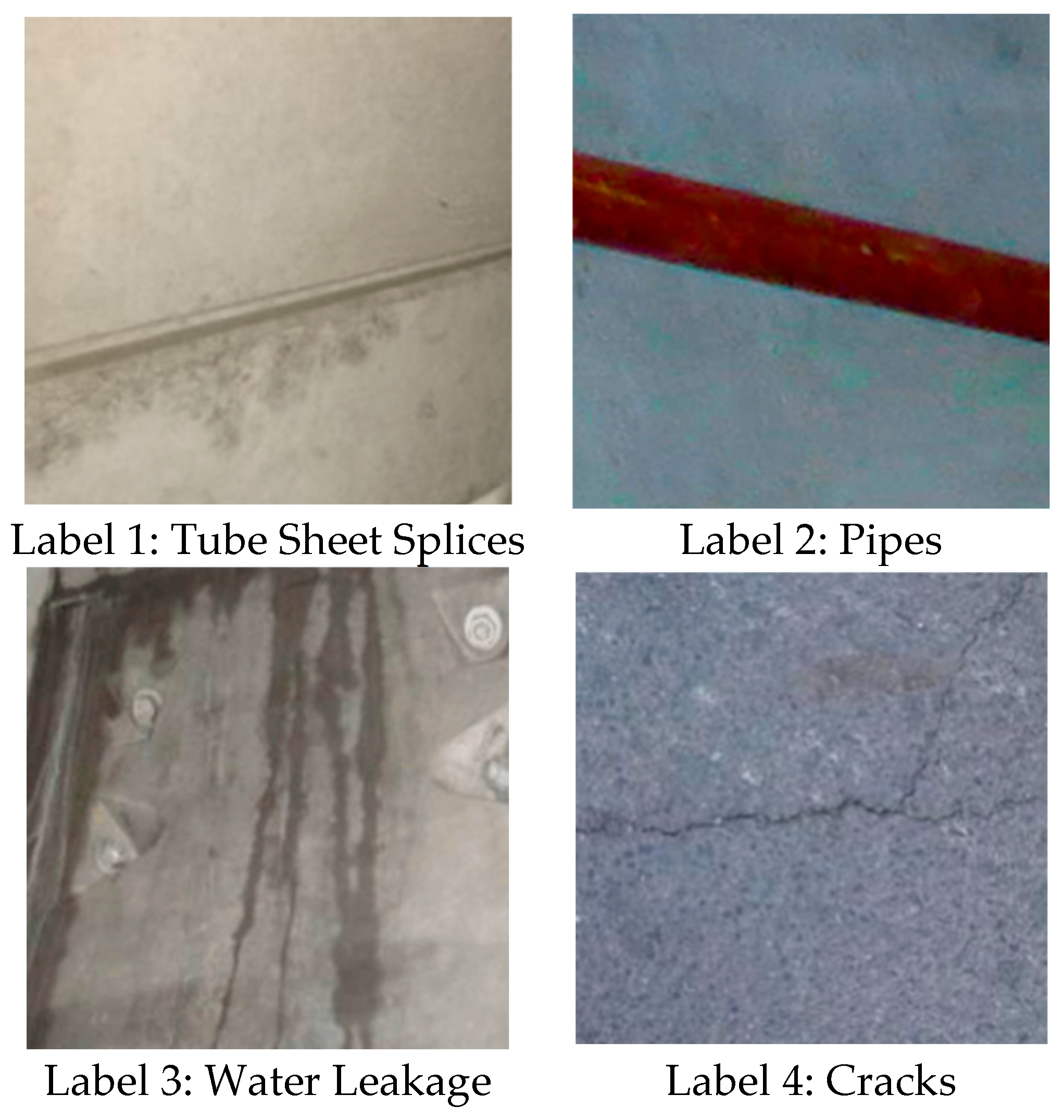
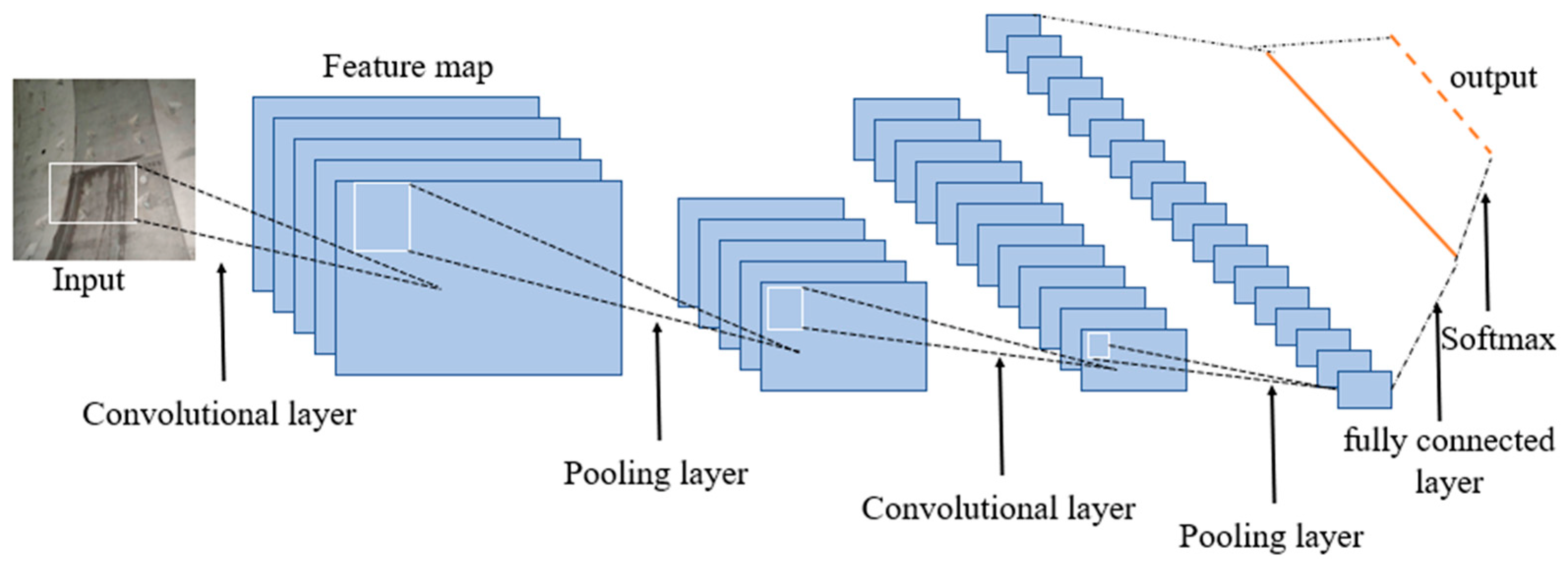

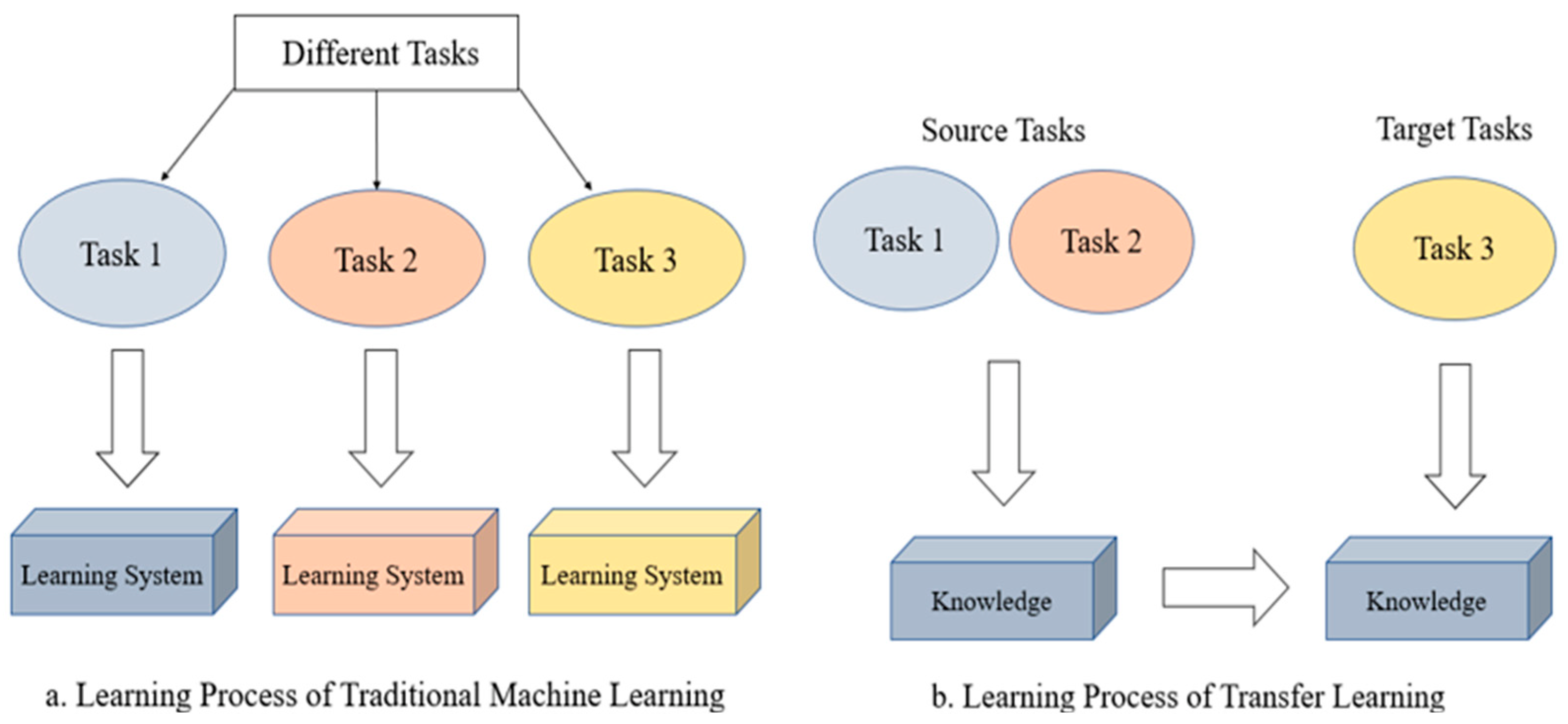
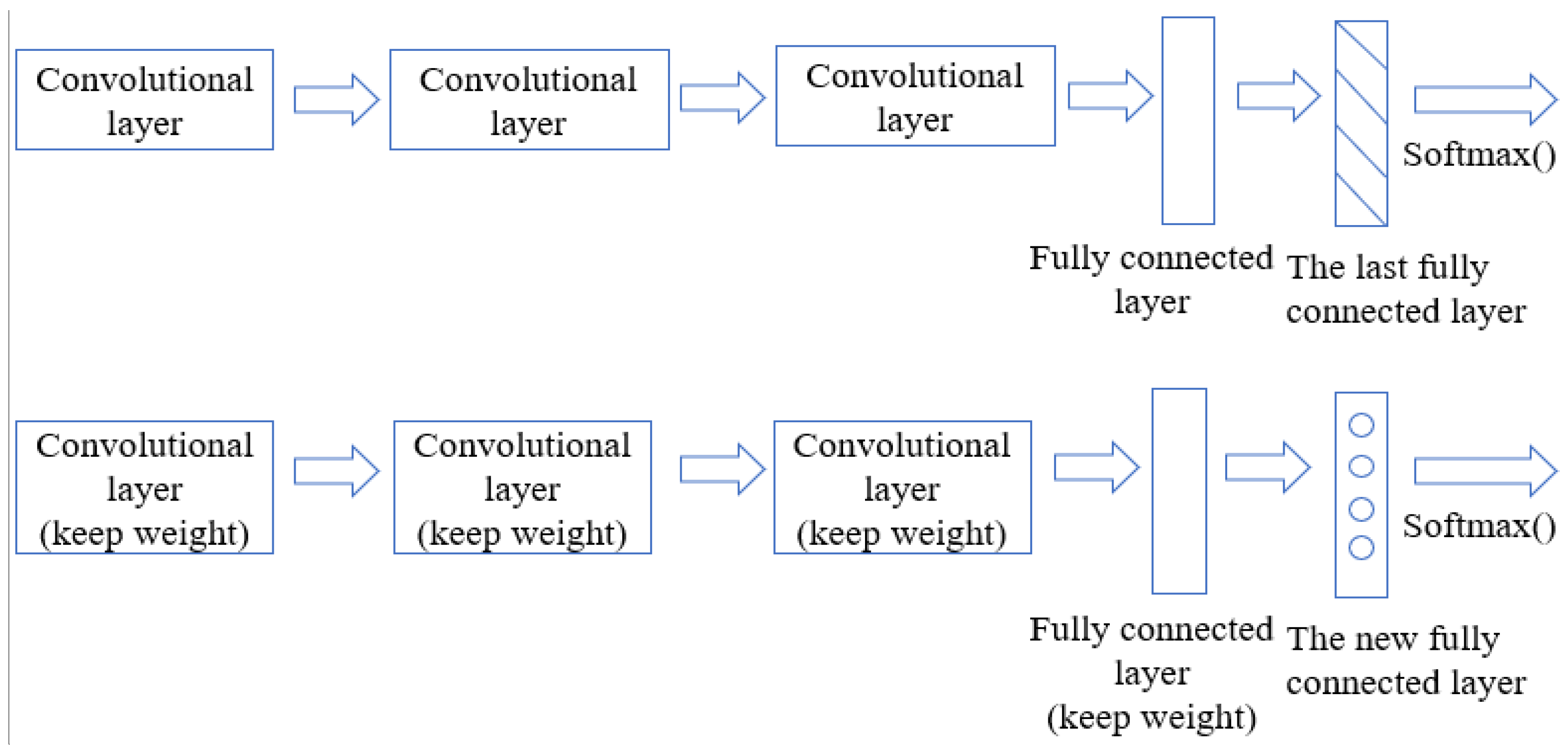
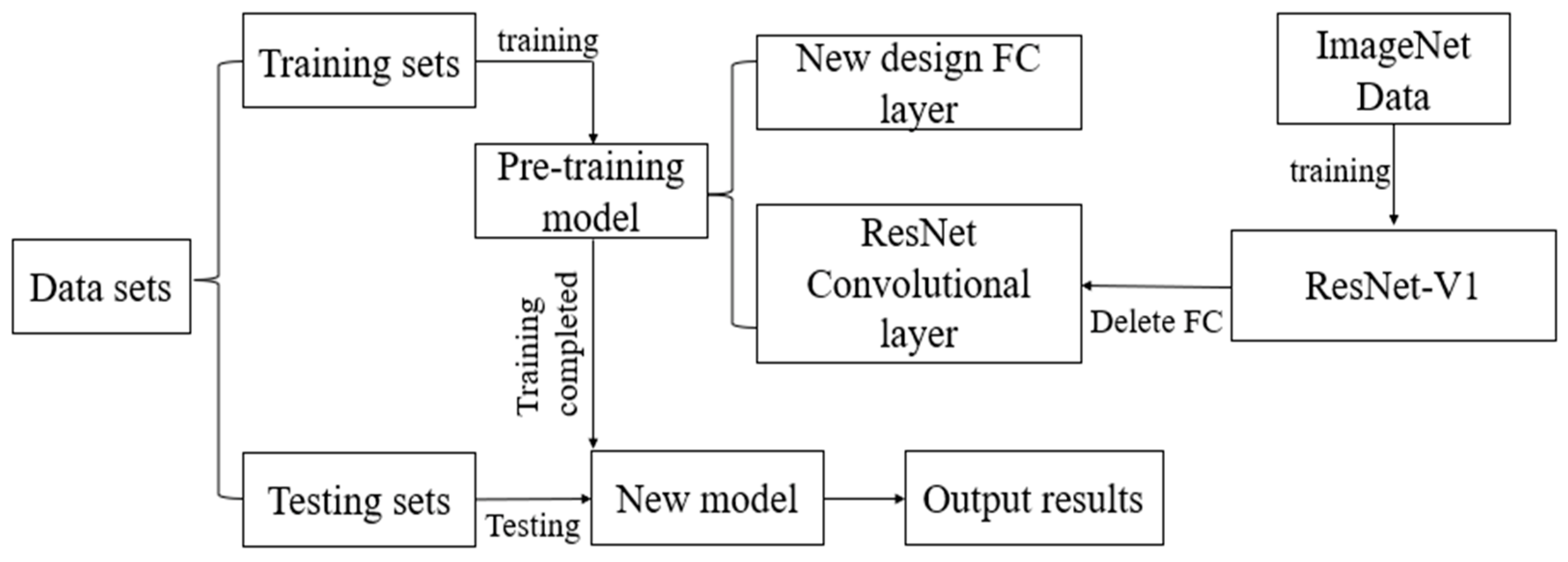
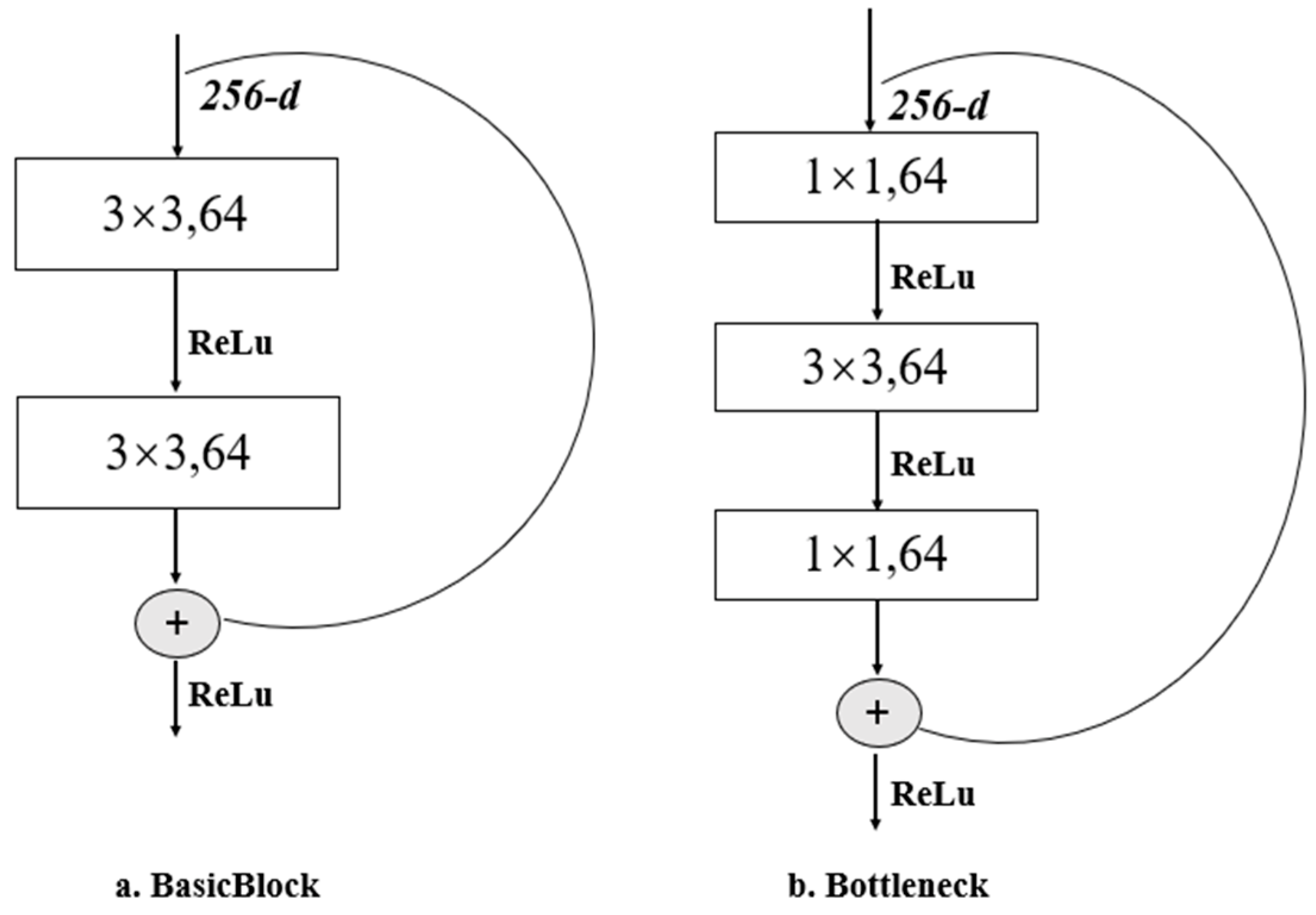

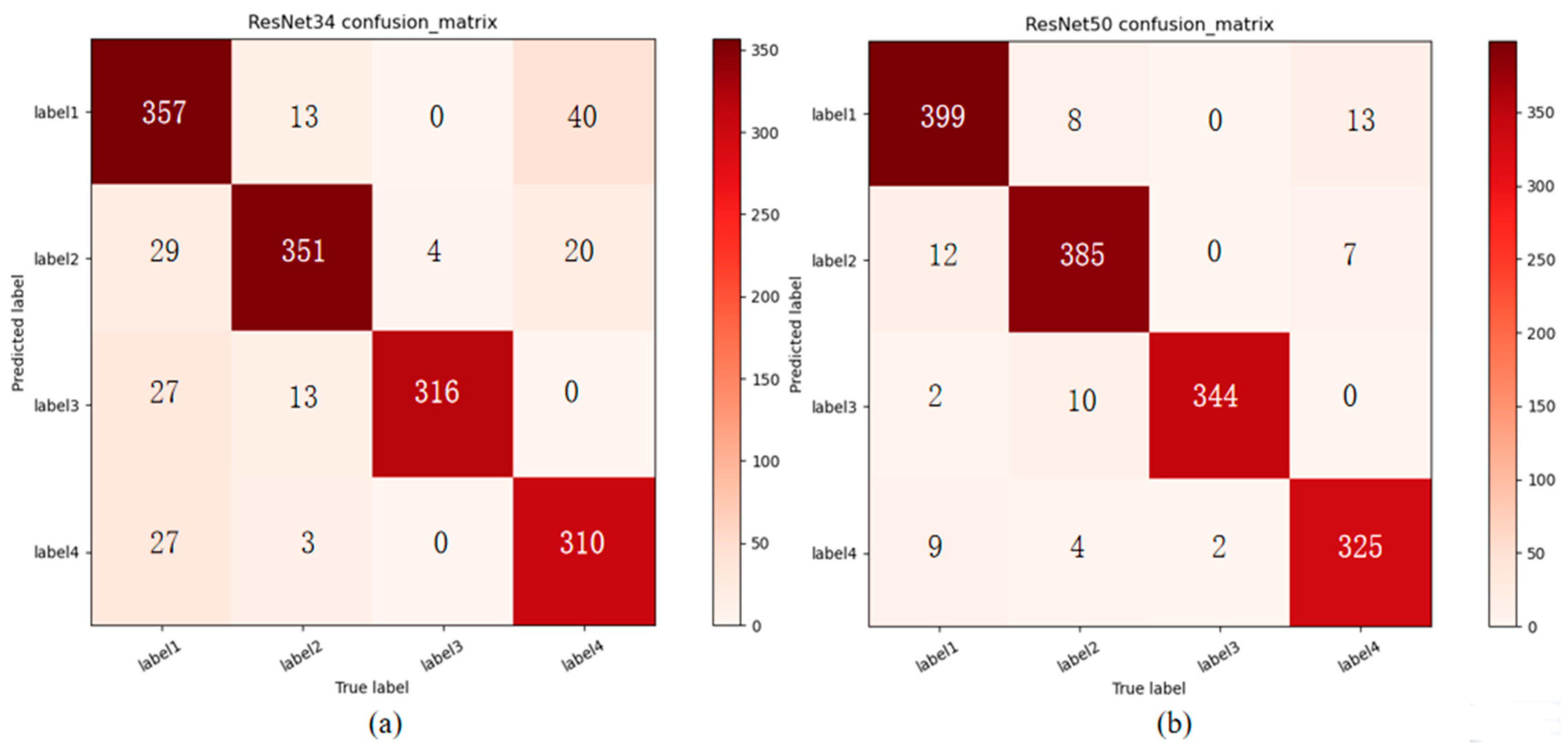
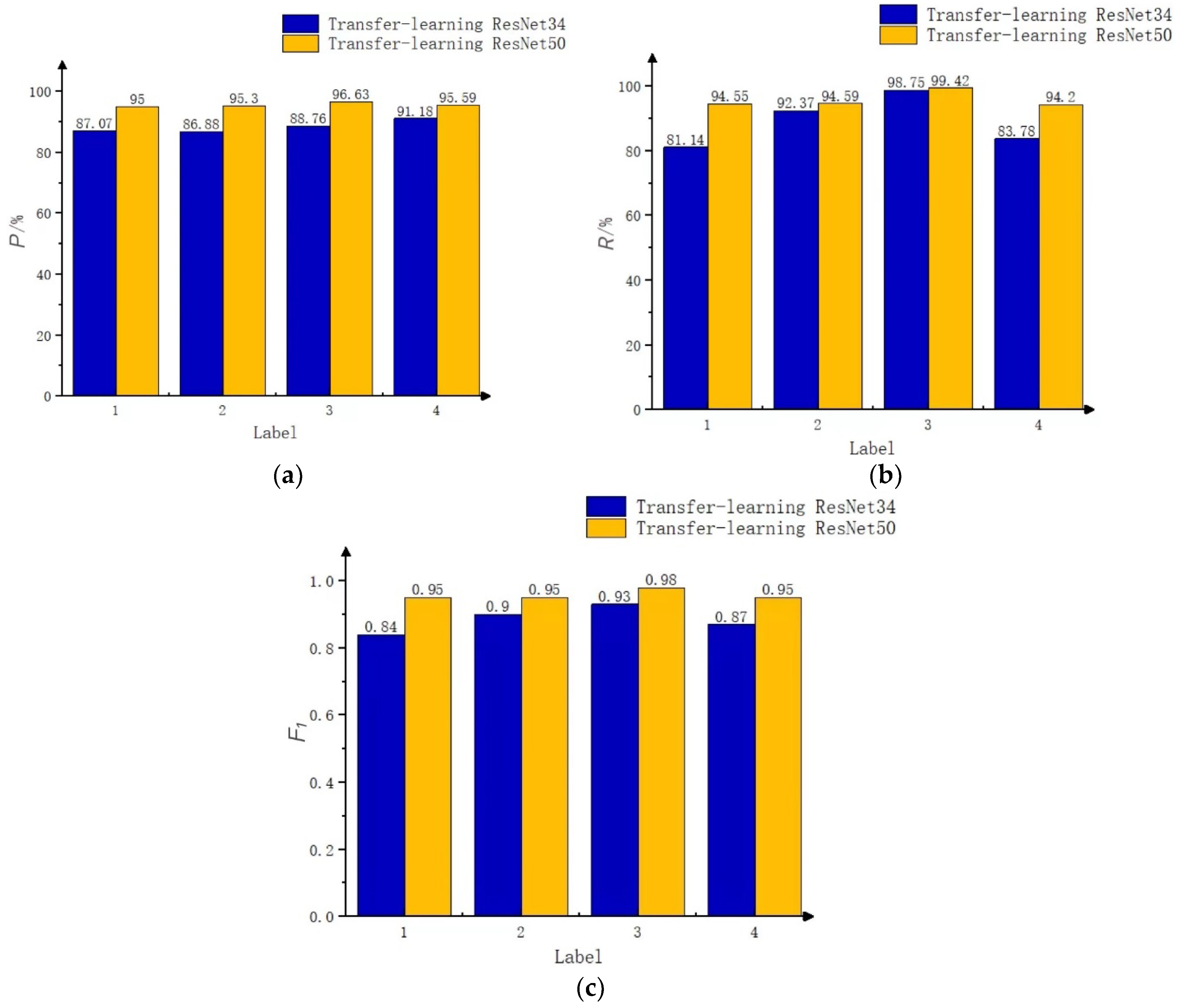
| Types of Tunnel Diseases | Sample Sets | Training Sets | Test Sets |
|---|---|---|---|
| Label 1 | 2100 | 1680 | 420 |
| Label 2 | 2020 | 1616 | 404 |
| Label 3 | 1780 | 1424 | 356 |
| Label 4 | 1700 | 1360 | 340 |
| Total | 7600 | 6080 | 1520 |
| Confusion Matrix | True Value | ||
|---|---|---|---|
| Positive | Negative | ||
| Predicted value | Positive | TP | FP |
| Negative | FN | TN | |
| Labels | P/% | R/% | F1 |
|---|---|---|---|
| 1 | 87.07 | 81.14 | 0.84 |
| 2 | 86.88 | 92.37 | 0.90 |
| 3 | 88.76 | 98.75 | 0.93 |
| 4 | 91.18 | 83.78 | 0.87 |
| Labels | P/% | R/% | F1 |
|---|---|---|---|
| 1 | 95.00 | 94.55 | 0.95 |
| 2 | 95.30 | 94.59 | 0.95 |
| 3 | 96.63 | 99.42 | 0.98 |
| 4 | 95.59 | 94.20 | 0.95 |
Publisher’s Note: MDPI stays neutral with regard to jurisdictional claims in published maps and institutional affiliations. |
© 2022 by the authors. Licensee MDPI, Basel, Switzerland. This article is an open access article distributed under the terms and conditions of the Creative Commons Attribution (CC BY) license (https://creativecommons.org/licenses/by/4.0/).
Share and Cite
Man, K.; Liu, R.; Liu, X.; Song, Z.; Liu, Z.; Cao, Z.; Wu, L. Water Leakage and Crack Identification in Tunnels Based on Transfer-Learning and Convolutional Neural Networks. Water 2022, 14, 1462. https://doi.org/10.3390/w14091462
Man K, Liu R, Liu X, Song Z, Liu Z, Cao Z, Wu L. Water Leakage and Crack Identification in Tunnels Based on Transfer-Learning and Convolutional Neural Networks. Water. 2022; 14(9):1462. https://doi.org/10.3390/w14091462
Chicago/Turabian StyleMan, Ke, Ruilin Liu, Xiaoli Liu, Zhifei Song, Zongxu Liu, Zixiang Cao, and Liwen Wu. 2022. "Water Leakage and Crack Identification in Tunnels Based on Transfer-Learning and Convolutional Neural Networks" Water 14, no. 9: 1462. https://doi.org/10.3390/w14091462
APA StyleMan, K., Liu, R., Liu, X., Song, Z., Liu, Z., Cao, Z., & Wu, L. (2022). Water Leakage and Crack Identification in Tunnels Based on Transfer-Learning and Convolutional Neural Networks. Water, 14(9), 1462. https://doi.org/10.3390/w14091462







